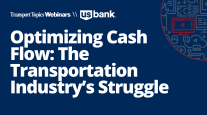Opinion: Automating Purchase, Payment Functions Can Benefit Fleets
Fleet managers often can become overwhelmed. They need to invest in new equipment and make decisions that are impacted by labor and financial markets as well as regulatory and legislative changes. It can be difficult to gain operational efficiencies amid fluctuating market conditions.

Clark
However, some fleets are looking closely at the back office as a key way to gain efficiencies. Historically, the procure-to-pay process, which integrates the purchasing department with the accounts payable department, was not one where fleet managers focused their attention. Yet, when it comes to purchasing both direct and indirect products and services, fleet managers can benefit from P2P solutions, which can connect the dots between each player in the business-to-business, or B2B, transaction and balance the contradictory needs of suppliers, who want to be paid faster, with buyers, who want to hold on to capital longer.
Financial process automation, therefore, is capable of unlocking the strategic value in a fleet’s purchasing and payment process. Simply stated, financial process automation streamlines the entire cycle from purchase order to invoice processing to approval workflow to payments. Technology-enabled services automate processes that have traditionally been manual, more prone to errors and which can contribute to a loss in time and revenue. Automation not only removes processing bottlenecks but secures an audit trail for compliance and improves visibility throughout the supply chain.
Historically, fleets have been slow to adopt automation of their back-office processes. Only 47% of businesses can process an invoice straight through with no manual intervention, according to Ardent Partners. But automation simplifies the purchase, pay and “get paid” processes with the potential to decrease costs.
When an electronic purchase order is generated, all the parties involved — procurement, accounts payable and supplier — have visibility into that PO and the subsequent actions (receipt of goods and invoices).
Supplier onboarding to the automated system facilitates a more streamlined P2P cycle but is not necessary for automation to be implemented at any one company. Onboarding is often an added service for many automation providers and builds in visibility that benefits the supplier as well as the fleet. Suppliers soon learn that they can get access to early payment discounts and rebates — an incentive to take the initial step to automate by sharing a single, cloud-based platform. Many P2P services also offer a payment component, which can deliver electronic payments to suppliers once they’ve been approved.
Because all documentation and information is captured and stored within the system, accounts payable has visibility into invoice status, allowing fleets to get better control of outgoing cash flow; procurement has visibility into supplier history, allowing fleets to negotiate contracts more effectively; and suppliers can see where their invoices are in the payment cycle.
Saving money is a benefit of automating the P2P process but so is saving time and relationships. When everything from POs to invoices to payments are available electronically, there is an instant connection between all parties as well as a data trail to validate and measure all transactions. A digital record for every payment and transaction means that fleets can build strong buyer-supplier relationships, control their working capital and gain full visibility into every dollar spent.
Fleets can turn to financial process automation technology to offset the costs in other areas, including equipment and driver wages and benefits. This technology also gives fleets control to free up money that could be used to improve their company’s overall efficiency.
Corcentric provides procurement and finance services to businesses.




